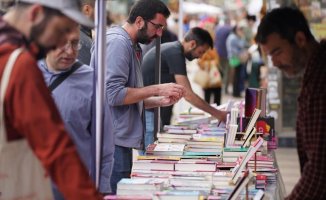The Parisian painter Georges Seurat had a very brief career, and yet his work delighted Van Gogh, Matisse, Picasso, Henry Moore and Jasper Johns. He died at the age of 31, in 1891, after barely 11 years of career, although he had become one of the great artists of the 19th century and after having contributed to founding neo-impressionism. Richard Serra was another of the artists he seduced thanks to his genius. "That's what I want to do," he enthused in 2008, after visiting a collection of drawings by the French artist. The art critic Judith Benhamou captured that moment, which has led to the latest exhibition at the Guggenheim Museum Bilbao.
The Serra/Seurat exhibition. Drawings brings together a selection of 22 drawings by the French master and puts them in dialogue with Serra's work; specifically with 81 drawings from the Ramble series, created in 2015.
The admiration of the North American artist for Seurat has been the incentive that has made the exhibition possible. “Seeing Serra euphoric after visiting Seurat's drawing collection in Paris, we thought something had to be done. The Kingdom of Serra is the Guggenheim Bilbao, so I proposed it to Juan Ignacio Vidarte, director of the museum”, explains Benhamou, curator of the exhibition together with Lucía Aguirre.
This exhibition is based on the premise that drawings form an essential part of the work of the two artists. Paul Signac described in 1899 this aspect of Seurat's work as "the most beautiful painter's drawings that exist". Decades later, Matisse, Picasso, Moore, Jasper Johns, Bridget Riley or Serra himself would buy these works.
In the case of Serra, better known for his sculpture, the author himself recognized that the drawings constitute "the most direct and conscious space" in which he can work. "It is one of the few circumstances in which I can understand the source of my work," said the artist. Lucía Aguirre points out that “Serra's work cannot be understood without his drawings”.
Now, the exhibition puts Seurat's works in dialogue with the shadow and chiaroscuro drawings that Serra made in lithographic crayon and pastel dust on handmade Japanese paper, the Ramble series.
The 22 drawings by Seurat exhibited in this exhibition reflect landscapes, such as Sunset at Gravelines or Muro del Camino; human silhouettes, Girl or Rolling up her sleeves; or the atmospheres of La Vela Blanca or Puerta. They also show his "concern for the workers", his interest in showing enigmatic characters or his technical expertise to "illuminate the darkness and light in his drawings":
In his works, the support he uses, paper, is especially important. In most of it he uses the French Michallet, which is characterized by its irregularities, its heavy texture and its undulations or ridges. “Seurat knew how to take drawing to new levels and, with his works on paper, he managed to enter the Olympus of the great masters of these techniques. Sasi gives life to the paper”, indicates Aguirre.
In the case of Serra's drawings, the support, a Japanese paper, also acquires a capital importance. "Manufactured by hand, each sheet, each fiber that makes it up, generates different accidents," explains Aguirre.
The play of colors of the Ramble de Serra, the combinations of black and white, are another key to the exhibition. Each and every one of the paintings in this series is different, even though its elements are common.
The arrangement of these works, of a weighted size, leads one to pay attention to the process and the drawings, despite their limited size, acquire considerable monumentality. The distance between a figurative artist from the end of the 19th century and an “abstract and conceptual” creator from the 19th century, face to face, is immense a priori. This exhibition, however, poses a suggestive confluence.
The sample can be visited until next September 6.













